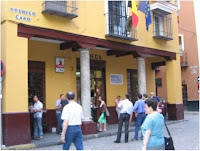
My One & Only Ethnography
The title of my one and only ethnography is: “Passionate Performance or Contrived Commodity?: Ethnicity and Nationalism through the Lens of Andalucian Flamenco.”
Flamenco, Spain, and I bang into each other a bunch of times in my life, it seems. There are, after all, lots of apparent as well as invisible convergences in life, right? Or is it better to call them coincidences?
Take, for example, the interrelated yet uncanny facts that 1) I studied abroad while in college at the University of Sevilla in Spain, and, 2) that during the summer of 2005, I went back to conduct my first (and probably only) ethnography. Then, 3) when I prepped for my interviews at National Geographic, I picked up a copy of Traveler magazine from Books A Million, a bookstore flanking Dupont Circle, and in it found a short piece about Sevilla and what there is that’s “authentic” to see and experience there. And the circle continues ‘round and ‘round, don’t it?
For those non-anthro dorks out there, an ethnography is Anthropology’s signature product. It literally means, from the Latin (right?), “writing culture.” It requires the anthropologist (or student) to get themselves out into “the field” and study something. Study it intently, in depth, with critical, keen eyes.
Take extensive notes on it and, after returning from the wilds, write it all down or type it all up, depending on which method you choose.
Traditionally and still typically (this is something that jars my bones and annoys me a lot about anthropology and its elitist and ironically close-minded tendencies … but more of that later) anthropologists study “the other,” the dark, “primitive” “one on the margins” and “the field” is far away from home, usually a place infested with scary bugs and nasty diseases. Worms in the rivers, monsters in the shadows, mites in the bed.
When you choose to study something in the “first” world (as I did) and not a topic the studying of which will likely get you killed or sick, other anthropologists deign acknowledge your work. In fact, for her project, a fellow GW grad school student of mine studied how gentrification patterns in DC are affecting low-income African Americans. The department was in inner turmoil when deliberating whether or not to offer her the grant as many faculty members thought her topic was not “anthropological” enough. What nonsense!
Yea, surely, her topic strays from the traditional, signature anthropological topics à la Malinowski and Mead, Sapir and Boas, Dobzhansky and the Leakeys, but it deals with people. Anthropology is, after all, the study of people, is it not?
So, as I mentioned just before during the summer of 2005, before my last semester at graduate school, I headed to Sevilla, Spain, to conduct my first and last ethnography.
Sevilla is the capital of Andalucia, a southern region in Spain. Andalucia is known for its sprawling yet orderly groves of olive trees, dry swaths of tawny soil, Moorish castles and fortifications such as the fragrant El Alcazar in Sevilla and the breath-taking Alhambra in Granada’s snowy Sierra Nevada, and wailing, sorrow-laden flamenco.
Some time ago GW’s Anthropology department was bequeathed a relatively large amount of money from an alumnus. The department wormed the money away, into a bank account and promptly forgot about it.
Once it was finally “remembered,” the money had grown to be a pretty nice amount. Each year, the department awards five to seven grants to both undergrad and grad students to design, plan, and executive anthropological fieldwork of their own.
I cobbled together a proposal and one March morning, checked my department mailbox to learn I had been awarded $1,600 to conduct my ethnography of flamenco dance performance.

Comments